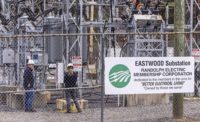A new study from the National Research Council warns that the electric grid in the United States is vulnerable to terrorist attacks and needs immediate attention.
Systematic attacks by a terrorist group could cause much more damage than natural disasters such as Hurricane Sandy and leave large swathes of the country in the dark for extended periods of time, the report concludes.
The report, released on Nov. 14, paints a picture of a power system that is physically vulnerable to attack for a variety of reasons: a grid that is spread out of hundreds of miles, with many key facilities unguarded; antiquated infrastructure in some areas, and an overly burdened grid that could experience multiple, cascading failures in the event of an attack.
The report’s lead author, M. Granger Morgan, professor and head of the department of engineering and public policy at Carnegie Mellon University in Pittsburgh, says that large blackouts could cost the nation billions of dollars. “Power system disruption experienced to date in the United States, be they from natural disasters or malfunctions, have had immense economic impacts, he says. “Considering that a systematically designed and executed terrorist attack could cause disruptions even more widespread and of longer duration, it is no stretch of the imagination to think that such attacks could produce damage costing hundreds of billions of dollars.
The report stresses the importance of investment in power system research, and notes that the current level of investment in this research is currently much smaller than it should be.
The study authors found high-voltage transformers to be of particular concern because they are vulnerable both from within and outside the substations where they are located. According to the report, these transformers are large and difficult to move, and are difficult to replace. Most are no longer manufactured in the United States, and the delivery time for new ones could run from months to years.
A promising solution is to manufacture a stockpile of “universal recovery transformers” that would be smaller and easier to move. Although only a temporary fix, they would drastically reduce delays in restoring disabled electric power systems.
The report added that the system could be made more robust and resilient by prioritized modernization of power plant and transmission infrastructure. In the near term, rather than building new power plants or transmission lines, enhancements at existing facilities and lines could be done relatively quickly and at a lower cost, the study authors said.
The report recommends that the Dept. of Homeland Security and or the Dept. of Energy initiate and fund several model demonstration assessments across cities, counties, and states to systematically examine a region’s vulnerability to extended power outages and develop strategies to minimize or even eliminate those vulnerabilities.
The NRC completed the report in the fall of 2007, but DHS, which sponsored the study, decided that the information should be kept classified. The report was ultimately cleared for public release in fall 2012.
In a foreword to the report, Charles M. Vest, president of the National Academy of Engineering, says that the key findings of the report remain “highly relevant.” He says, “We understand the need to safeguard security information that may need to remain classified. But openness is also required to accelerate the progress with current technology and implementation of research and development of new technology to better protect the nation from terrorism and other threats.”
The NRC is planning a workshop to address changes that have occurred since the report was originally completed.



Post a comment to this article
Report Abusive Comment